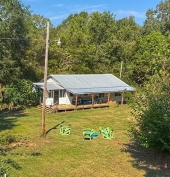
 9
9




 11
11




 9
9




 1
1




Regards, Scott
 8
8




Nothing ruins a neighborhood like paved roads and water lines.
 7
7




 2
2






 5
5




 5
5




The organizer recommended silver queen corn, rattlesnake beans, okra, tomatoes, yellow squash, and purple hull peas as crowd favorites and said that strawberries, carrots, turnips, fennel, lima beans, English peas, and butterbeans would also be welcome.
Invasive plants are Earth's way of insisting we notice her medicines. Stephen Herrod Buhner
Everyone learns what works by learning what doesn't work. Stephen Herrod Buhner
 6
6
 1
1




Emily Smith wrote:What about a heavy duty tiller to break up the turf and then go no till after that? Is that reasonable? I'm not sure how else to break it up. It's St. Augustine, Bermuda, and crabgrass.
 2
2




Skandi Rogers wrote:
No the smell repellents do not work, get the fencing sorted before you put out a buffet for the rabbits.
 4
4








Regards, Scott
 4
4




 7
7






 5
5




I make a Maple Syrup instructional movie! Check it out HERE
SKIP books, get 'em while they're hot!!! Skills to Inherit Property
See me in a movie building a massive wood staircase:Low Tech Lab Movie
 2
2




Mike Haasl wrote:One detail to consider is how much money you'll actually make. After expanding the gardens, buying all the stuff, putting your time in, buying a new place, etc. Will you be making $100 a market or $500? If it's $100 would your time have been better spent at a workee job?
I guess what I'm trying to get at is that market farming isn't a quick/easy buck. It's lots of hard work. Even after putting in the hard work it might just not be worth the money earned.
Sorry to be the devil's advocate or a downer but it's worth doing the math...
 6
6




 8
8




Mike Haasl wrote:One detail to consider is how much money you'll actually make. After expanding the gardens, buying all the stuff, putting your time in, buying a new place, etc. Will you be making $100 a market or $500? If it's $100 would your time have been better spent at a workee job?
I guess what I'm trying to get at is that market farming isn't a quick/easy buck. It's lots of hard work. Even after putting in the hard work it might just not be worth the money earned.
Sorry to be the devil's advocate or a downer but it's worth doing the math...
 6
6




Emily Smith wrote:
So the newest development is the business licensing people require a license to sell to the permies, and they won't give me one unless I'm operating on at least 10 acres... which in my area could go for $75k-$150k. Yet the nonprofit farmer's market lady said I didn't need one, so I'm confused. I'm looking at the next county over (15-20 minute drive for me)...
 5
5




Christopher Staley wrote:As one who has spent the last four years building a market garden, I think the statement above sums up the reality of a one person market garden. I feel like you will have to charge a premium for your crops to make enough profit to afford inputs and to live. That typically means the big city, or farmers markets where the big city comes to shop on the weekend. It took me four years to build my soil and the infrastructure to run a market garden, but I am finding it difficult to find avenues to sell. Ultimately I will likely end up at a farmers market many miles away closer to the big city where I have to pay a fee to have a booth. There just isn't a lot of extra money for booths, marketing, gas, compost, etc...
 4
4




 4
4




 2
2




 2
2






|
Gravity is a harsh mistress. But this tiny ad is pretty easy to deal with:
The new purple deck of permaculture playing cards
https://www.kickstarter.com/projects/paulwheaton/garden-cards
|








